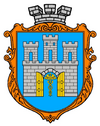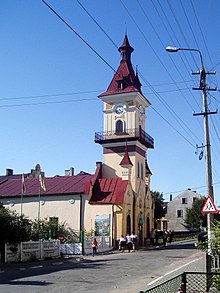Rawa-ruska
| Rawa-ruska | ||
| Рава-Руська | ||

|
|
|
| Basic data | ||
|---|---|---|
| Oblast : | Lviv Oblast | |
| Rajon : | Zhovkva district | |
| Height : | 241 m | |
| Area : | 10.41 km² | |
| Residents : | 8,159 (2004) | |
| Population density : | 784 inhabitants per km² | |
| Postcodes : | 80316 | |
| Area code : | +380 3252 | |
| Geographic location : | 50 ° 14 ' N , 23 ° 38' E | |
| KOATUU : | 4622710400 | |
| Administrative structure : | 1 city | |
| Mayor : | Alla Soprun | |
| Address: | вул. Ярослава Мудрого 3 80316 м. Рава-Руська |
|
| Statistical information | ||
|
|
||
Rawa-Ruska ( Ukrainian Рава-Руська ; Russian Рава-Русская Rawa-Russkaja , Polish Rawa Ruska , Yiddish Rave , ראווע) is a city in the far west of Ukraine on the border with Poland .
geography
It is located on the small river Rata and belongs to the Lviv Oblast . Rawa Ruska is located about 60 km northwest of Lviv .
history
Rawa-Ruska was first mentioned in writing in 1455. In 1698 August the Strong , King of Poland and the Russian Tsar Peter I met here and formed an alliance in preparation for the Northern War against Sweden. Until the first division of Poland in 1772, the city in the Ruthenian Voivodeship belonged to the aristocratic republic of Poland , then until 1918 to the Habsburg monarchy (from 1867 Cisleithanien , crown land of Galicia ).
Even before the First World War , the city was an important railway junction, lines from Lviv , Krakow and Lublin met here, and in 1887 a train station was built on what is now the Lviv – Hrebenne line. It was also of administrative importance, since 1850 it was the seat of the district administration Rawa Ruska , in 1867 a district court was also established in the village.
From September 3 to 11, 1914, the Battle of Rawa Ruska took place in and around the city as part of the Battle of Galicia between Austro-Hungarian and Russian troops . It ended with a Russian victory.
After the First World War, the city belonged to the newly established Polish state . From 1921 it belonged to the Lviv Voivodeship .
Second World War
In September 1939, Rawa Ruska was initially occupied by German troops , after their retreat behind the agreed demarcation line by the Red Army and incorporated into the Ukrainian Soviet Republic . The border with the General Government ran immediately northwest of the city.
At the end of June 1941 at the start of the war against the Soviet Union , the city was conquered by the Wehrmacht, and on 1 August 1941 as part of the eastern Galicia joined the General Government and the seat of a Kreishauptmannschaft . Kreishauptmann was first the later judge at the Federal Administrative Court Hans-Walter Zinser , then Gerhard Hager.
In a POW camp set up in the city, 18,000 Soviet soldiers may have died in 1941/1942. In March 1942, the Wehrmacht set up a penal camp in the city for French and Belgian prisoners of war ( Stalag 325 ) who were accused of trying to escape or refusing to work. The first transport of prisoners arrived on April 13, 1942.
History of the Jews
In March 1942, around 1,000 Jews, mostly elderly, were summoned in front of the criminal police headquarters and deported to the recently completed Belzec extermination camp , which was only 22 kilometers north-west of the city. On July 27, 1942, around 2,000 more Jews were deported to Belzec.
In a text known as the “Cornides Report”, the German sergeant Wilhelm Cornides described how he saw several transports when changing trains in Rawa Ruska on August 31, 1942 and overheard conversations about the fatal fate of the deportees.
Individual Jews managed to escape from the trains during what were sometimes all-day stays in Rawa. If they were not shot by the guards posted at the station, they could sometimes hide in the city. In September 1942, the Germans finally set up a spatially limited ghetto in the middle of the city center, in which not only the remaining Jews from Rawa Ruska were imprisoned, but also Jews from surrounding villages, so that 15,000 people soon had to live there. The ghetto was evacuated by the German and Ukrainian helpers in several actions between December 1942 and June 1943.
In their desperation, the Jews hid the sick and dying in holes in the ground to keep them from being accessed. Nevertheless, the SS and Police Leader of Galicia, Fritz Katzmann , was able to report in his final report, "Solving the Jewish Question in the Galicia District" of June 30, 1943, that 3,000 people had been taken out of hiding and thus succeeded "To destroy plague bump". During the so-called "actions", many of the Jews living in the Rawa-Ruska ghetto were murdered on the spot, and others were deported to Belzec or to the Lemberg-Janowska forced labor camp near Lemberg .
At the time, the International Committee of the Red Cross wrote a report on the evacuation of the ghettos in Galicia, which also dealt with a German massacre in December 1942 in Rawa-Ruska.
At the end of July 1944, the city was captured by the Red Army.
After 1945
After the Second World War, as in 1939 to 1941, it became part of the Ukrainian Soviet Republic. Rawa Ruska has been part of the independent Republic of Ukraine since 1991 .
traffic
In the northwest of the city there is a border crossing to Poland on the M 09 trunk road .
sons and daughters of the town
- Olgierd Górka (1887–1955), Polish historian
- Stefan A. Mayer (1895–1981), Polish intelligence officer
- Emil-Edwin Reinert (1903–1953), French director
- Julian Augustyn Duchowicz (1912–1972), Polish architect
- Iryna Vereschtschuk (* 1979), Ukrainian politician
literature
- Rawa Ruska , in: Guy Miron (Ed.): The Yad Vashem encyclopedia of the ghettos during the Holocaust . Jerusalem: Yad Vashem, 2009 ISBN 978-965-308-345-5 , pp. 648-650
Web links
- On the Extermination of the Jews by Rawa Ruska (in English)
- Ukrainian site with sights of Rawa Ruska
Individual evidence
- ↑ Rizzi Zannoni, Woiewodztwo Ruskie, Część Krakowskiego, Sędomirskiego Bełzkiego y z y granicami Węgier, Polski, Które gory Karpackie nakształt łańcucha wyciągnione, od góry Wolska aż do Talabry, wyznaczaią .; 1772 ( Memento of the original from November 20, 2015 in the Internet Archive ) Info: The archive link was inserted automatically and has not yet been checked. Please check the original and archive link according to the instructions and then remove this notice.
- ^ Reichsgesetzblatt of October 8, 1850, No. 383, page 1741
- ↑ deathcamps.org: Rava-Ruska



